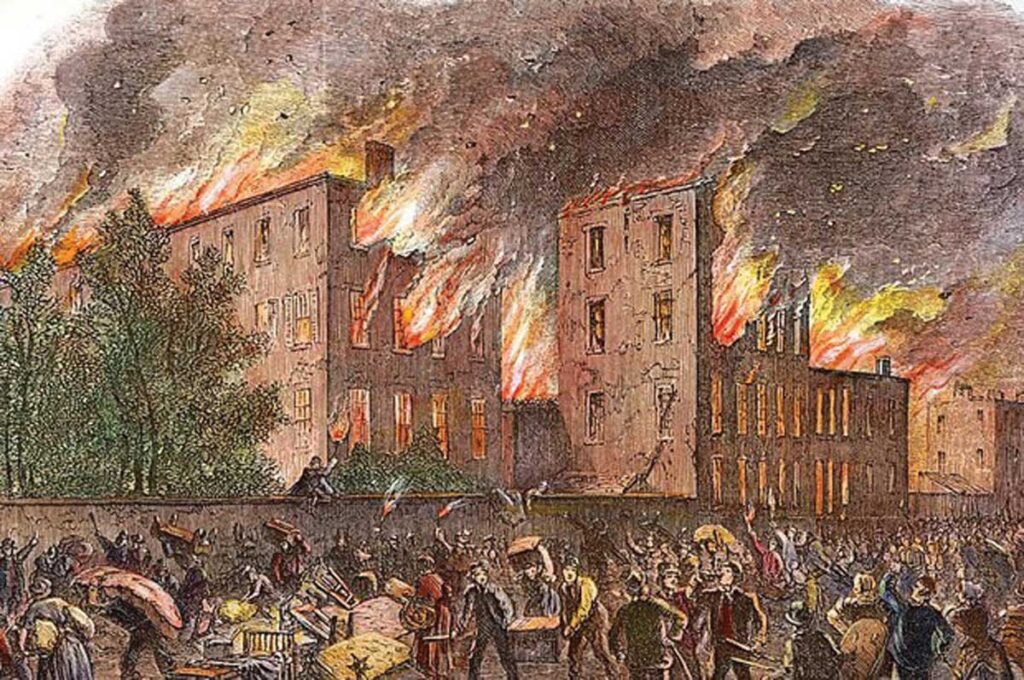Sidebar
Reconstruction Violence Beyond the South

Destruction of an orphanage for Black children during the 1863 New York City Draft Riots.
Reconstruction violence was not limited to the South. Deep racial hostility and the terrifying threat of violence permeated life for Black people across the country, even in the 16 “free states” where slavery had been mostly abolished before the Civil War.
As disagreements over the continuation of slavery escalated into a more prominent political dispute in the 1840s and 1850s, people in the North feared that Emancipation in the South would bring a wave of Black migrants to their states. Anti-Black sentiment grew more explicit in the North and states like Iowa, Illinois, and Oregon took steps to ban Black migration.1 Foner, Reconstruction, 26.
By 1860, Black people in the North—who comprised less than 2 percent of the population—were subjected to discrimination and resentment in every aspect of their lives.2 Ibid. In July 1863, several days of “draft riots” broke out in lower Manhattan in New York City. White mobs angered by the threat of being drafted to serve in the Union Army and resentful of fighting a Civil War to end slavery randomly attacked Black people on sight. The violence was quelled by state militia and federal troops, but not before more than 100 people were killed, most of them Black men.3 See Iver Bernstein, The New York City Draft Riots: Their Significance for American Society and Politics in the Age of Civil War (New York: Oxford University Press, 1991); James M. McPherson, Ordeal by Fire: The Civil War and Reconstruction (New York: Knopf, 1982).
In the years after the Civil War, Black people in the North faced prejudice and presumptions of guilt whenever a crime was discovered and suffered brutal violence at the hands of white mobs without any trial or process.
In 1866, a Black teenager named John Taylor was lynched by a mob of 200 white people in Mason, Michigan.4 Detroit Free Press, “The Lynching of the Delhi Murderer,” August 31, 1866. John was enslaved at birth in Nelson County, Kentucky.5 Chicago Tribune, “The Ingham County Tragedy,” August 30, 1866. He joined the Union Army at age 14, and later enlisted in the Michigan Colored Infantry.6 Ibid. After he was accused of killing a white girl near Lansing, the 17-year-old was denied a trial. A white mob convinced that a legal execution was “too good for such a wretch” seized him from jail.7 Ibid. Press accounts described his torturous murder at the hands of a mob yelling messages of anti-Black racial hatred.8 Richmond Dispatch, “A Negro Lynched in Michigan,” September 5, 1866.
The next year, in Georgetown, Colorado, Edward Bainbridge was accused of fighting with a white man in a local bar.9 The Rocky Mountain News, April 29, 1867. A white lynch mob kidnapped him from jail and left his body “dangling in the air.”10 Ibid.
Black people in the North were also targeted for exercising their citizenship rights. In 1871, on election day in Philadelphia, three Black men named Octavius Catto, Isaac Chase, and Jacob Gordon were killed by white mobs wielding violence to suppress the Black vote.11 The Baltimore Sun, “Riots in Philadelphia,” October 11, 1871; The Philadelphia Inquirer, “The Fifth Ward Murders,” October 14, 1871.
In summer 1875, a large crowd gathered at the local fairgrounds in Hancock County, Indiana, to watch the lynching of a Black man named William Kemmer. Mr. Kemmer, whose last name was also reported as “Keimer,” had been accused of assaulting a white woman. He died in a public spectacle lynching before he could prove his innocence. Thousands reportedly gathered to view his corpse and read a note the lynch mob had pinned to his coat: “It is the verdict of one hundred and sixty men at Hancock, Rush and Shelby, that his life is inadequate to meet the demands of justice.”12 Atchison Daily Patriot (Atchison, Kansas), “Indiana: Negro Hanged at Midnight by an Infuriated Mob,” June 29, 1875.
While Reconstruction-era violence was most frequent in the South, Black people living in the North and West also faced lynchings, racially motivated violence, and bigotry that continued for decades.